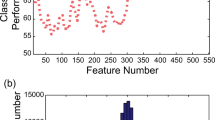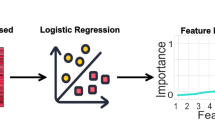Abstract
In this study, we tested whether the disturbed structural connectivity in whole brain cortex could be discriminating biomarker for schizophrenia. The anatomical fiber streamlines constructed on AAL template by diffusion tenor image were selected as potential features and a linear SVM pattern classifier was used to categorize the schizophrenia and healthy controls. We randomly divided the whole data into two groups, a training set which contained 32 patients and 25 controls and a test set had 31 patients and 24 controls. We compared two kinds of feature selection methods 1) Univariate t-test based filtering; 2) sparse regression based filtering. The sparse regression features correctly identified 97% cases in test dataset (96% sensitivity and 98% specificity), while the t-test significant impaired connectivity achieved 94% accuracy (92% sensitivity and 96% specificity). The sparse regression selected structural connectivities were consistent in 90% individuals 10 percent more than the t-test filtered features.
Access this chapter
Tax calculation will be finalised at checkout
Purchases are for personal use only
Preview
Unable to display preview. Download preview PDF.
Similar content being viewed by others

References
Orrù, G., Pettersson-Yeo, W., Marquand, A.F., Sartori, G., Mechelli, A.: Using support vector machine to identify imaging biomarkers of neurological and psychiatric disease: a critical review. Neuroscience & Biobehavioral Reviews 36, 1140–1152 (2012)
Ardekani, B.A., Tabesh, A., Sevy, S., Robinson, D.G., Bilder, R.M., et al.: Diffusion tensor imaging reliably differentiates patients with schizophrenia from healthy volunteers. Human Brain Mapping 32, 1–9 (2011)
Nieuwenhuis, M., van Haren, N.E., Hulshoff Pol, H.E., Cahn, W., Kahn, R.S., et al.: Classification of schizophrenia patients and healthy controls from structural MRI scans in two large independent samples. Neuroimage 61, 606–612 (2012)
Fornito, A., Zalesky, A., Pantelis, C., Bullmore, E.T.: Schizophrenia, neuroimaging and connectomics. Neuroimage (2012)
Zalesky, A., Fornito, A., Seal, M.L., Cocchi, L., Westin, C.-F., et al.: Disrupted axonal fiber connectivity in schizophrenia. Biological Psychiatry 69, 80–89 (2011)
Chu, C., Hsu, A.L., Chou, K.H., Bandettini, P., Lin, C., et al.: Does feature selection improve classification accuracy? Impact of sample size and feature selection on classification using anatomical magnetic resonance images. Neuroimage 60, 59–70 (2012)
First, M.B., Gibbon, M.: User’s guide for the structured clinical interview for DSM-IV axis I disorders: SCID-1 clinician version: American Psychiatric Pub. (1997)
Kay, S.R., Fiszbein, A., Opler, L.: The positive and negative syndrome scale (PANSS) for schizophrenia. Schizophrenia Bulletin 13, 261–276 (1997)
Wang, R., Benner, T., Sorensen, A., Wedeen, V.: Diffusion toolkit: a software package for diffusion imaging data processing and tractography, 3720 (2007)
Zhang, Z., Liao, W., Chen, H., Mantini, D., Ding, J.-R., et al.: Altered functional–structural coupling of large-scale brain networks in idiopathic generalized epilepsy. Brain 134, 2912–2928 (2011)
Ryali, S., Supekar, K., Abrams, D.A., Menon, V.: Sparse logistic regression for whole brain classification of fMRI data. NeuroImage 51, 752 (2010)
Bi, J., Bennett, K., Embrechts, M., Breneman, C., Song, M.: Dimensionality reduction via sparse support vector machines. The Journal of Machine Learning Research 3, 1229–1243 (2003)
Hermundstad, A.M., Bassett, D.S., Brown, K.S., Aminoff, E.M., Clewett, D., et al.: Structural foundations of resting-state and task-based functional connectivity in the human brain. Proceedings of the National Academy of Sciences 110, 6169–6174 (2013)
Fan, R.-E., Chang, K.-W., Hsieh, C.-J., Wang, X.-R., Lin, C.-J.: LIBLINEAR: A library for large linear classification. The Journal of Machine Learning Research 9, 1871–1874 (2008)
Author information
Authors and Affiliations
Editor information
Editors and Affiliations
Rights and permissions
Copyright information
© 2013 Springer-Verlag Berlin Heidelberg
About this paper
Cite this paper
Zheng, J., Wang, Y., Chen, H., Chen, H. (2013). Sparse Brain anatomical Network Based Classification of Schizophrenia Patients and Healthy Controls. In: Sun, C., Fang, F., Zhou, ZH., Yang, W., Liu, ZY. (eds) Intelligence Science and Big Data Engineering. IScIDE 2013. Lecture Notes in Computer Science, vol 8261. Springer, Berlin, Heidelberg. https://doi.org/10.1007/978-3-642-42057-3_102
Download citation
DOI: https://doi.org/10.1007/978-3-642-42057-3_102
Publisher Name: Springer, Berlin, Heidelberg
Print ISBN: 978-3-642-42056-6
Online ISBN: 978-3-642-42057-3
eBook Packages: Computer ScienceComputer Science (R0)



